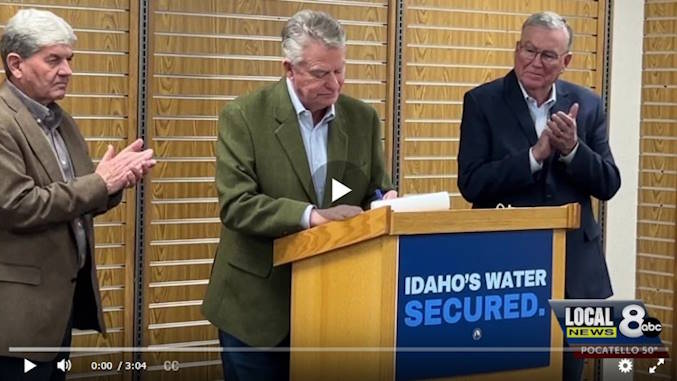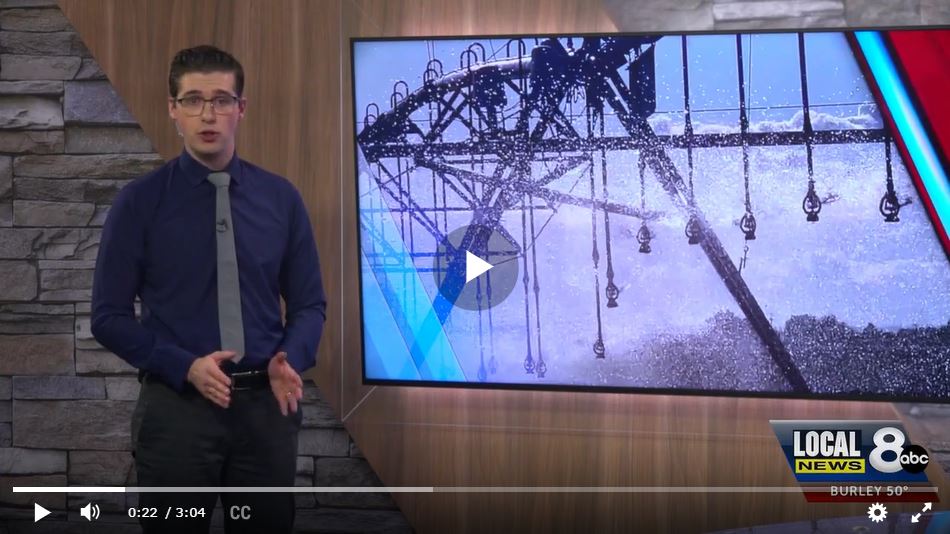
State officials celebrate new water agreement, but some farmers are concerned it won’t last
By Seth Ratliff
IDAHO FALLS, Idaho (KIFI) – This month, Idaho farmers reached a water deal that could prevent a future curtailment of Idaho farms. Now the state is celebrating the efforts of the farmers who came together to make that deal.
Governor Brad Little has marked today as Idaho water day, in celebration steps farmers took this year towards ensuring Idaho’s water for future generations
The Governor says the new water agreement safeguards Idaho’s water from outside intervention and provides safe harbor for farmers and water users on all sides of the state.
“It (The deal) gives the entire state that’s dependent upon irrigation, certainty and confidence when we go forward,” said Gov. Little.
2024 Mitigation Plan Breakdown
The new water agreement outlines how groundwater users will offset the water they pump from the aquifer over four year periods; the first beginning January 1, 2024, and ending December 31, 2027.
Start the conversation
Have your say.Leave a comment below and let us know what you think.
During the 4-year-term, each groundwater district will be responsible for a proportionate share of 205,000 acre-feet of groundwater in aquifer recharge.
Idaho Water Resource Board Chairman, Jeff Raybould, says that reduction will be accounted for every 4 years. It means groundwater irrigators can still avoid a curtailment during a dry year.
“You’ll get four years’ worth of water, and it’s up to each individual water user to manage that water as they see fit,” Raybould told members of the Natural Resources Interim committee late October. “If they want to be extra conservative and make sure they have extra water to get through all four years, they can do that. If they have a little bit, extra, at least from the first four-year block to the second for your block, they’ll be able to carry that over.”
Ground water districts will also be required to secure 75,000 acre-feet of storage water for the 2025 and 2026 irrigation seasons to provide to any member of the Surface Water Coalition (SWC) in the event of a water shortfall.
At the end of each 4-year-term, the agreement will automatically renew “unless a party provides written notice of termination to the other parties by September 15 prior to the end of term.”
Members of both the SWC and groundwater districts ratified the agreement November 15th.
An achievement or another agreement sure to dry up?
But not all parties are convinced the deal will last. Many members of the eastern Idaho community, including Bingham County farmer Brian Murdock, believe the groundwater farmers entered the negotiations at a disadvantage.

“Unless there is snow, this agreement is bound to fail,” Murdock told Local News 8.
Murdock says under the new agreement the Bingham Groundwater District is required to limit the amount of water allocated to each farmer based on the age of their water rights in order to comply and mitigate the water they pump.
“We’re getting some of these farmers with later priority dates with not a lot of water to grow a crop,” said Murdock. “In fact, if you’re trying to grow hay on some of these amounts that you are going to be allowed to grow, you’re not going to be able to do it. Or you’re only going to get two crops of hay out of it per year, rather than the three or the four that you’re used to getting.”
Idaho State representative, Idaho farmer, and member of the negotiation team Stephanie Mickelsen says farmers may need to adapt what and how they farm in order to keep their business while complying with the new agreement.
“I think you (groundwater farmers) have a choice. You can either lengthen out your rotations and be able to stay in business. You’re going to have to be a lot smarter about managing that resource of water.”
With the new limitations on water usage, Murdock says many of his fellow groundwater users in Bingham County are looking into other options.
“We’re driving anyone who can get back on a canal to get back on a canal, and therefore that then limits the amount of surface water available for recharge,” said Murdock.
In addition to the agreement, the state has increased its own aquifer recharge target to 350,000 acre-fee a year. Murdock says he’s concerned the states efforts to recharge the aquifer could them in direct competition with farmers for a limited resource.
“The state is saying they will recharge 350,000 acre feet, which that’s a good thing. Unless they then become our competitor to purchase any extra water that is available. Therefore they get first dibs on it or they beat us to it, and therefore we can’t get the water to recharge.”
On the other hand, Representative Mickelsen says the 2024 agreement was the best one available.
“The deal that we got for groundwater users was the best deal that was available to us, given the restraints that we had from having to keep the aquifer from a state of decline and being able to keep the economy going across the Magic Valley and up in here into Eastern Idaho,” Mickelsen told Local News 8.
From localnews8.com
